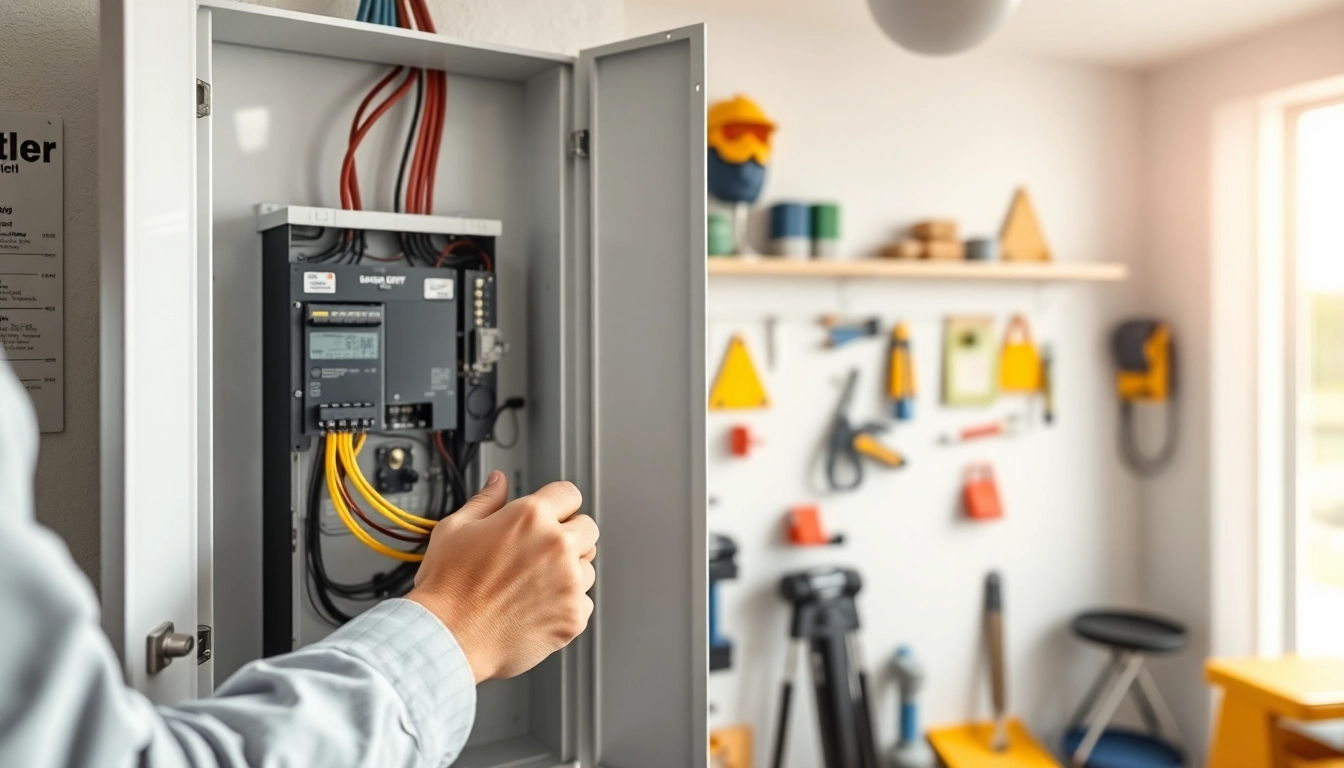Introduction to Electrical Panel
Definition and Purpose of Electrical Panel
An Electrical Panel, sometimes referred to as a breaker box or distribution board, is an essential component of a residential electrical system. Its primary role is to distribute electrical power from the utility service to different circuits throughout the home. The panel houses circuit breakers or fuses that protect these circuits from overloads and shorts, ensuring safety and efficiency in household energy consumption.
Electrical panels serve as the central hub for electricity, controlling and directing the power supply to various electrical devices and outlets. A well-functioning electrical panel is crucial for managing the electrical load of a home, thus safeguarding it from potential hazards such as electrical fires or system failures.
Common Types of Electrical Panel
There are several types of electrical panels, each designed for specific applications and power needs. The most common types include:
- Main Breaker Panels: These panels have a single main circuit breaker that controls all the electrical supply to the circuits attached to it. It is typically used in residential settings.
- Subpanels: Subpanels are smaller panels that distribute power to specific areas of the home or for special circuits, such as those in garages or workshops.
- Smart Panels: Equipped with advanced technology, these panels allow homeowners to monitor their electricity usage in real-time and make adjustments to optimize efficiency.
- Load Centers: These are designed to hold multiple circuit breakers in one unit and are often found in residential or small commercial setting.
Importance of Electrical Panel in Home Safety
The electrical panel plays a critical role in ensuring home safety. With the correct installation and maintenance, it can prevent electrical fires and system overloads. The panel acts as a frontline defense against surges and electrical faults, effectively managing the power distribution to minimize the risk of hazards.
Regular inspections and necessary upgrades to the electrical panel can help identify potential issues before they escalate into dangerous situations. A modern panel with adequate capacity and proper circuit protections enhances home safety and ensures compliance with the latest electrical codes.
Recognizing When to Upgrade Your Electrical Panel
Signs That Indicate Panel Upgrade Is Needed
Upgrading the electrical panel is sometimes necessary to accommodate changing power needs. Here are some signs that indicate it might be time to upgrade:
- Constantly Tripped Breakers: Frequent tripping can indicate that the panel is unable to handle the electrical load.
- Insufficient Outlets: If you’re frequently using extension cords or power strips, it may be time for more outlets, which typically require an upgraded panel.
- Old or Damaged Panel: If your panel is outdated or showing signs of wear and tear, an upgrade can enhance safety and reliability.
- New Appliances: Installation of high-demand appliances such as electric heaters, air conditioners, or hot tubs often necessitates an electrical panel upgrade.
How Electrical Load Affects Panel Performance
Electrical load concerns the total amount of electricity consumed by all devices and appliances connected to the electrical panel. As homes evolve with additional electronic devices and appliances, the demand for electricity typically increases. This growing demand can exceed the capacity of an existing electrical panel, leading to performance issues.
Understanding your household electrical load is essential. A qualified electrician can analyze your current load and recommend a panel that can effectively support additional devices while maintaining safety standards.
Age of Electrical Panel and Replacement Considerations
The age of an electrical panel can significantly affect its performance and safety. Most panels have a lifespan of 25 to 40 years. If your panel is approaching this age, it’s crucial to consider an upgrade. Older panels may not comply with modern safety standards and can lack necessary protections against electrical faults.
Furthermore, advancements in electrical technology often render older panels inefficient. If you live in an older home with an outdated panel, upgrading can improve capacity, safety features, and energy efficiency.
Choosing the Right Electrical Panel for Your Needs
Factors to Consider When Selecting an Electrical Panel
When choosing an electrical panel, several factors come into play:
- Amperage Rating: The amperage rating of the panel must be adequate for the total expected load. Common ratings include 100, 200, and 400 amperes.
- Connection Style: Ensure compatibility with the service line and circuit systems in your home.
- Size and Configuration: Evaluate the size requirements based on home layout and where the panel will be installed. Options include both single-phase and three-phase configurations.
Understanding Amperage Ratings of Electrical Panel
The amperage rating refers to the maximum amount of current the panel can safely handle. A standard home usually requires a 100 amp panel; however, for homes with increased electrical needs, a 200 amp panel may be more appropriate. Understanding these ratings helps to ensure that the panel selected can support all devices and future needs without risk of overload.
Consulting with an electrical professional is advisable for accurate assessments of household demand, ensuring the panel selected has adequate capacity for current and future use.
Evaluating Panel Features and Technology
Modern electrical panels come equipped with various features designed to enhance functionality and safety. Common features to consider include:
- Surge Protection Devices: Protecting appliances from voltage spikes.
- Smart Technologies: Panels that allow for remote monitoring and management.
- Multiple Circuit Options: Greater flexibility for circuit positioning and capacity management.
Evaluating these features can help in choosing a panel that meets both current requirements and future needs.
Installation Process for Electrical Panel
Preparing for Electrical Panel Installation
Before proceeding with the installation of an electrical panel, proper planning is essential. Homeowners should take the following steps:
- Check Local Codes: Ensure compliance with local electrical codes and regulations.
- Assess Current Wiring: Inspect existing wiring for wear and verify compatibility with the new panel.
- Schedule Power Outage: Coordinating with the utility provider to temporarily disable power to your home for safe installation.
Step-by-Step Guide to Installing an Electrical Panel
The installation process of an electrical panel should be undertaken by a qualified electrician to ensure safety and compliance with codes. Here’s a general guide:
- Remove the old panel (if applicable) along with any existing circuit breakers.
- Install the new mounting bracket securely in place.
- Connect service wires to the new panel, ensuring proper grounding.
- Add new circuit breakers based on the household load requirements.
- Test the panel for functionality and secure any access doors.
Hiring a Professional vs. DIY Panel Installation
While some homeowners may consider DIY installation for cost savings, hiring a licensed electrician is highly recommended for safety reasons. Professional electricians have the expertise, knowledge, and tools needed to ensure a proper and code-compliant installation. They can also assist in troubleshooting any existing issues efficiently.
DIY installations can pose significant safety risks, expose homeowners to higher costs if repairs are necessary from improper installs, and potentially result in liability if the work is not up to code.
Maintenance and Troubleshooting of Electrical Panel
Routine Maintenance Tips for Electrical Panel
Proper maintenance can prolong the lifespan of your electrical panel and enhance safety. Homeowners should consider the following:
- Regular inspection: Examine the panel for any signs of wear, rust, or discoloration.
- Cleanliness: Ensure that the panel is free from dust and debris.
- Documentation: Keep a record of all panel upgrades, changes, and issues.
Common Issues and How to Fix Them
Electrical panels can present several issues over time, such as tripped breakers, flickering lights, or signs of electrical burning. Here are common problems and suggested fixes:
- Tripped Breakers: Usually caused by overloads; reevaluating the load distributed across circuits may resolve this.
- Flickering Lights: Often indicates poor connections; further inspection of wiring and circuit connections might be indeed required.
- Burning Smell: This could indicate a severe issue like overheating; immediate consultation with a professional is necessary.
Safety Precautions When Working with Electrical Panel
Safety is paramount when handling electrical panels. Always take the following precautions:
- Wear insulated gloves and safety goggles.
- Ensure all power is turned off before opening the panel.
- Utilize properly rated tools and equipment when working.
Whenever in doubt, consult with a licensed electrician rather than attempting to resolve complex issues personally.



